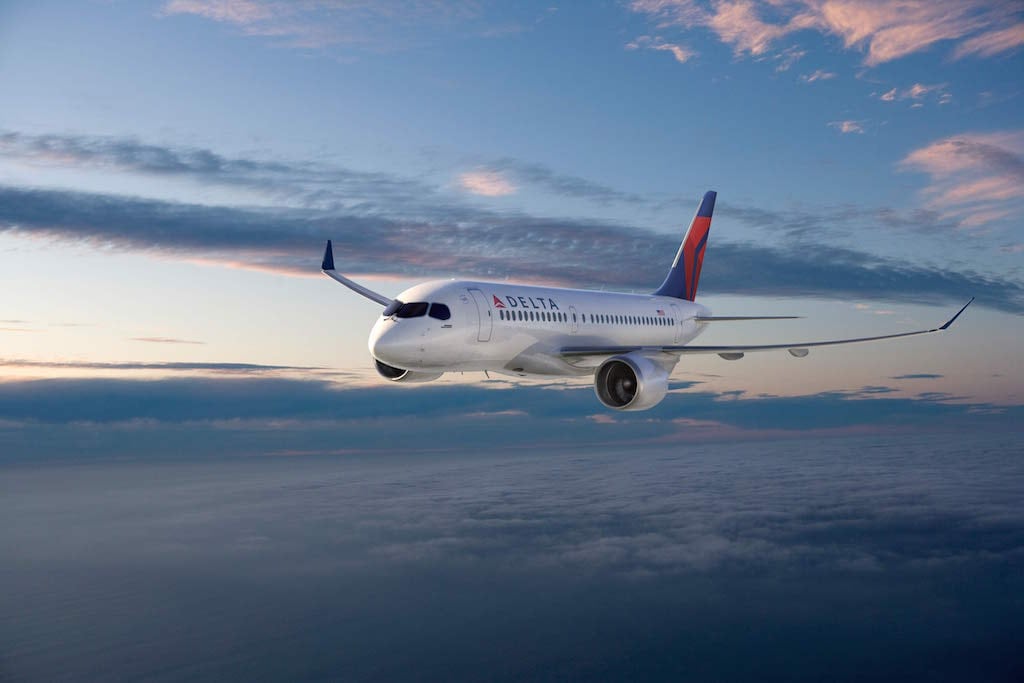Skift Take
Who says airlines don't prioritize passenger comfort? As long as carriers calculate passengers are willing to pay for a better experience, they will provide it.
When Delta Air Lines takes delivery of its newest — and likely most passenger-friendly — narrow-body jet early next year, it plans to deploy them in markets where its most lucrative passengers fly, an executive said Monday at a conference in Denver.
Delta will be the first U.S. airline to take delivery of the Airbus A220-100, a new, high-tech airplane with relatively wide seats and a roomy, quiet cabin. Delta ordered the roughly 100-seat aircraft in 2016, before Airbus acquired a majority interest in what was then called the Bombardier C Series. Airbus changed the aircraft’s name in July, and has begun to market it more aggressively, having recently sold 60 of the larger A220-300 to JetBlue Airways.
Joe Esposito, Delta’s senior vice president for network planning, said Delta expects to use the aircraft to replace regional jets on longer competitive routes such as New York to Dallas/Fort Worth, an American Airlines hub, and New York to Houston, a United Airlines hub.
Fewer Middle Seats
While Delta likes the new jets for their economics — the A220s will be cheaper to operate on a per-seat basis than other similarly sized jets — passengers should like them because, with a two-by-three configuration, they have fewer middle seats than typical larger jets.
“You will see us put those in competitive areas,” Esposito said at the International Aviation Forecast Summit. “We are going to start with our biggest markets.”
Delta usually flies Embraer E175s on both New York-Texas routes, and although those aircraft are more comfortable than regional jets of a decade ago, they’re still not competitive with larger mainline airplanes, especially on fights that can push four hours. And since they’re branded as Delta Connection, they’re flown by contractors, so Delta can’t control the passenger experience as well as it can on aircraft it operates.
Normally, airline customers don’t care what aircraft they fly, or aren’t willing to pay a premium for a more comfortable experience. But there are some exceptions, as in the competitive New York market, where United Airlines, American Airlines and Delta all vie for the same lucrative corporate customers.
Until a couple of years ago, United flew less comfortable 50-seat regional jets from Newark to Atlanta, a decision that cost United some business because Delta flew larger airplanes on the same route, United President Scott Kirby has said.
Focus Cities
Most of Delta’s traffic continues to flow through its key markets of Atlanta, Minneapolis, Detroit, Los Angeles, New York, Seattle and Salt Lake City. But Delta is exploring with point-to-point routes in some U.S. cities with robust economies, building sizable operations in Austin, Boston, San Jose, and Raleigh, North Carolina.
It’s a much different strategy than American and United, both of which push almost all travelers to connect in their largest hubs. With its focus cities, Delta’s approach is more similar to Southwest Airlines, which will go into nearly every U.S. market provided it calculates it can make money.
“We are definitely still building up our hubs, but we will look for opportunities in markets that are unserved where we think we can come in and offer a great product,” Esposito said. “In terms of Raleigh-Durham, you can go and look and say, ‘Where do the consumers want to fly?’ You just go down that list and then [you ask], ‘Do we have the opportunity to to make that work?'”
Delta can be aggressive as it builds focus cities. Last month, it announced it will add three daily flights from Raleigh to Chicago O’Hare beginning in April 2019. United and American both fly the route, but they’re in the business of using their massive Chicago hubs to facilitate passenger connections to other places in the United States and abroad.
For Delta, the goal is simpler: To fly Delta frequent flyers in Raleigh to Chicago.
“It’s really for the Raleigh customer,” Esposito said. “We have such a big loyal following there that the next thing they want is Chicago, which we don’t serve. It’s [a] process of going through and understanding where the consumers want to go. We have great data on that.”
It’s not just domestic flights. Delta has been adding routes to Europe from outside its hubs, with transatlantic fights from Pittsburgh, Indianapolis, Raleigh, Orlando and Boston. American has just one such flight from a non-hub — from Raleigh to London — while United has none.
The flights work because passengers can connect on KLM in Amsterdam or Air France in Paris to other cities in Europe, as well as to Africa and the Middle East. About two thirds of the passengers on the Raleigh to Paris nonstop connect onward in Paris, Esposito said.
“We’re looking for more of those opportunities,” he said.
The Daily Newsletter
Our daily coverage of the global travel industry. Written by editors and analysts from across Skift’s brands.
Have a confidential tip for Skift? Get in touch
Tags: airbus, airline innovation, delta air lines, hubs, seats
Photo credit: Delta Air Lines plans to use its first batch of Airbus A220s in key business markets where they can replace regional jets. Delta Air Lines
